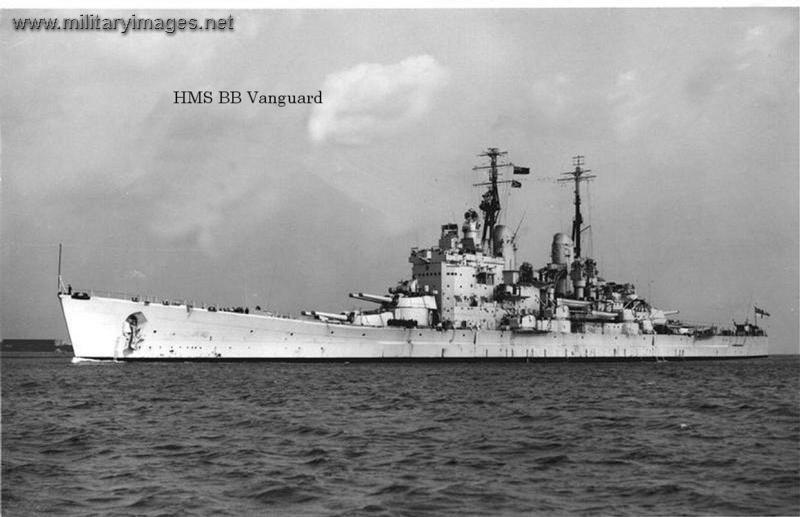- Extended Description
- HMS Vanguard was a Fully Armoured Battlecruiser of the Royal Navy. She was the biggest and last battleship to be built for the Royal Navy.
Early in 1939, the Admiralty decided to build a new battleship that would use four spare twin 15 inch mountings originally used by HM ships Courageous and Glorious during World War I; thus giving rise to the nickname "battleship with her great aunt's teeth".
A design for a 40,000-ton battleship was produced, intended to be the core of a Far East Fleet, where her high speed and armament would be a match for Japanese warships. At the outbreak of World War II the Admiralty decided to concentrate the limited shipbuilding resources on vessels that could come into service quickly rather than larger or more powerful ships that might be too late. As a result the planned Lion class was cancelled. It was suggested that the turrets and mountings from the two battlecruisers be utilized in a modified Lion design for speedy construction. The plan was approved and the ship built.
Vanguard was laid down in 1941, by John Brown and Company, Clydebank, Scotland, and her hull was launched in November 1944; however, the ship was not commissioned until 1946, and became known as the only British battleship never to fire her guns in anger. It is interesting to note, however, that whilst the mounts were intended to be used for Courageous and Glorious, the actual guns were from a pool of guns that had been used on several ships including Queen Elizabeth, Royal Sovereign and others. One single gun had been on either Courageous or Glorious but came to Vanguard via HMS Warspite[1]. Two of the mounts themselves had been intended for Renown and Repulse before going to Courageous and Glorious.
She performed various duties as flagship and training ship; and even as a "Royal Yacht" when, in 1947, she took the royal family of George VI to South Africa. This was the first time his daughter Elizabeth II, then a Princess, ever left Britain. Vanguard was finally decommissioned in 1959, having never seen combat. In 1960 she was towed from Portsmouth. During the tow, she nearly struck the harbour side and became temporarily grounded. It looked like the harbour might be blocked but prompt action and the efforts of the tugs pulled her free before the tide dropped. She made the journey to Faslane, Scotland over the next five days and was scrapped there after efforts to turn her into a museum were unsuccessful.
Vanguard was unique among British battleships in having remote power control (RPC) for main, secondary and the tertiary guns. There were two director control towers (DCT) for the 15 inch guns, each carrying a "double cheese" Radar Type 274 centimetric fire control set for rangefinding and spotting the fall of shot. There were four US Navy type Mark 37 DCT for the 5.25 inch guns, each carrying the twin domes of Radar Type 275, a centimetric fire control set. Lastly, each Mark VI sextuple 40 mm Bofors mounting had its own CRBF "close range blind fire" director fitted with RP50 RPC and Radar Type 262. The Type 262 was a centimetric set transmitting through a small parabolic dish giving a narrow search cone. The antenna was spun off-axis at high speed to produce a wider cone capable of locking on to a target. The STAAG Mk.I 40 mm Bofors mounting carried its own Radar Type 262 on the mounting itself. Originally this was located below the gun barrels, but it was subject to excessive vibration and was later relocated to the top of the mounting. Other radar sets carrier were Type 960 air warning, Type 293 target indication and Type 277 height finding.
Vanguard was well regarded as a good seaboat, able to keep an even keel in rough seas. This was due to the large flare applied to the bows after experience with her predecessors, the King George V class. The latter had been built with no sheer to the main deck forwards to allow firing of Turret A straight ahead at 0 of elevation, resulting in a poor seaboat that took a lot of water over the bows. During NATO exercises in the 1950s Vanguard's main deck was dry in heavy North Atlantic swells whereas US Navy Iowa-class battleships had their forward turrets awash with spray (although considered good sea boats, the Iowa-class ships' narrow bows took on a lot of spray because they didn't have enough flare to keep it out of the ship).















